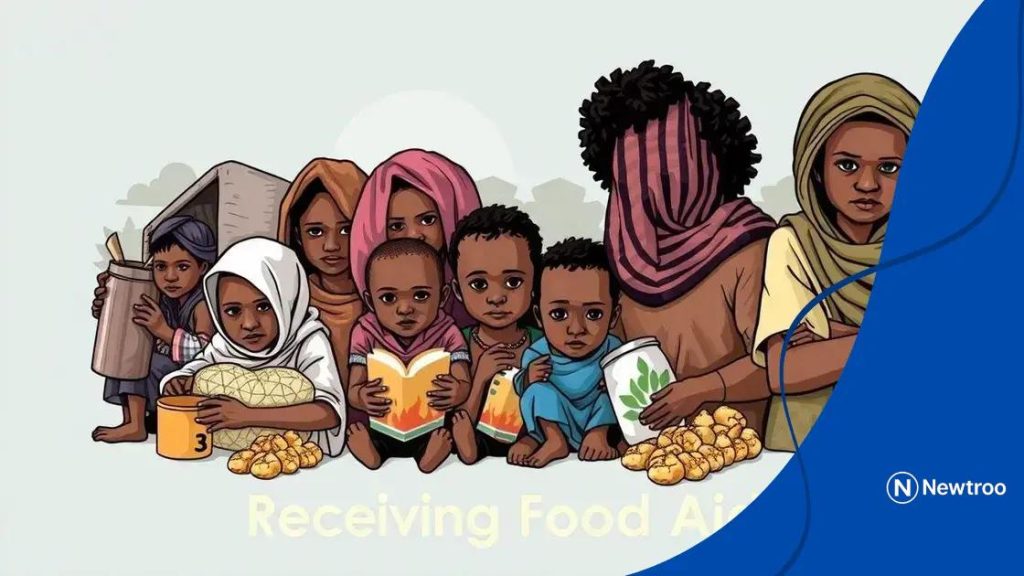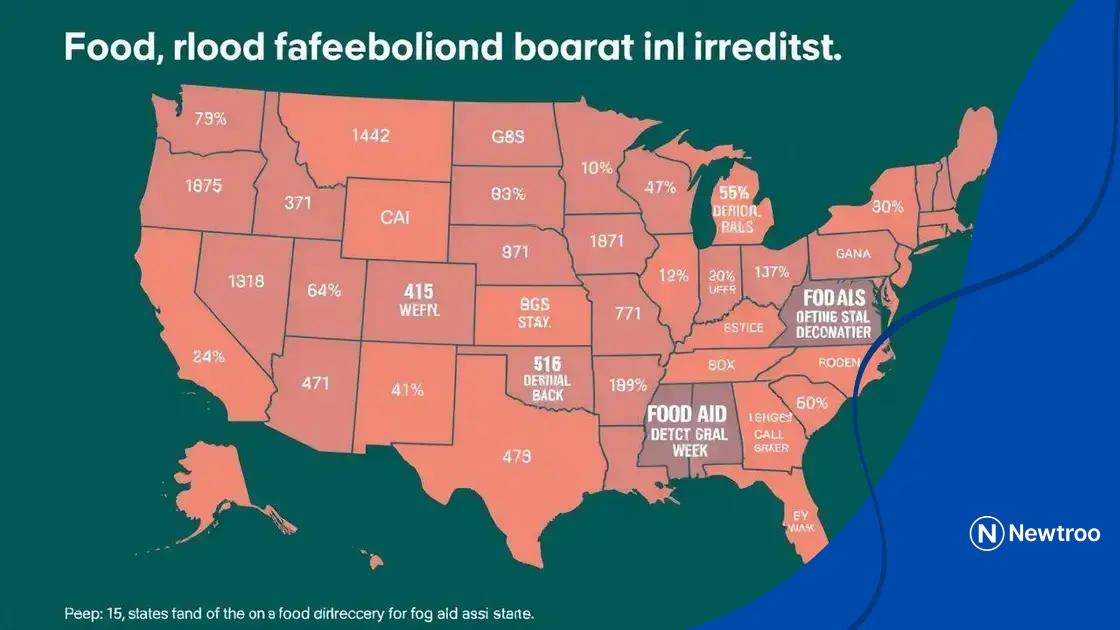State-by-state breakdown reveals food aid impact disparities

Anúncios
State-by-state breakdown reveals food aid impact disparities, highlighting how factors like geography, community engagement, and policy influence access to assistance for those in need.
The state-by-state breakdown reveals food aid impact disparities that often go unnoticed. Have you ever wondered how these differences truly affect communities across the country? Let’s dive into the details and understand the stories behind the statistics.
Anúncios
Understanding food aid distribution
Understanding food aid distribution is essential to grasp how resources reach those in need. It plays a critical role in ensuring that individuals and families have access to nutritious food. Food aid aims not only to alleviate hunger but also to support long-term food security.
The process of food aid distribution involves various organizations, including local governments, non-profits, and community groups. Each entity plays a part in ensuring food reaches the right hands at the right time. One significant aspect of this distribution is the method used to allocate resources. Factors such as location, population size, and specific needs influence how food assistance is delivered.
Key Aspects of Food Aid Distribution
A few key considerations help clarify how food aid is processed and distributed:
Anúncios
- Targeted Assistance: Programs may tailor food aid to specific populations, such as children or seniors.
- Emergency Responses: In times of disaster, rapid distribution methods are critical for immediate food relief.
- Community Involvement: Local organizations often facilitate distribution, making it more effective and responsive to community needs.
Moreover, understanding the logistics behind food aid helps address challenges in the distribution process. These challenges can range from transportation issues to varying levels of community outreach. For instance, in urban areas, congestion can delay delivery times, while in rural settings, access to remote locations can pose significant hurdles.
Impact of Food Aid Distribution
The impact of effective food aid distribution can be profound. When done right, it reduces hunger and improves health outcomes. Communities with efficient food aid systems often see a reduction in food insecurity, leading to better overall well-being.
On the other hand, discrepancies in food aid distribution can create inequities. Areas that receive less support may continue facing high rates of food poverty, leading to ongoing challenges. This inequality underscores the importance of strategic planning in food aid initiatives.
Finally, ongoing assessments of food aid programs can help identify gaps and improve future distribution efforts. Continuous feedback ensures these programs remain effective and serve their intended purpose of alleviating hunger across all regions. Such evaluations not only facilitate better resource allocation but also promote knowledge-sharing among aid organizations.
Factors influencing food aid disparities
Factors influencing food aid disparities are crucial to understand the differences in how food assistance is provided across various regions. These disparities can have significant impacts on communities, affecting who receives aid and how much they get.
One major factor is geographical location. Urban areas typically have more resources, leading to a greater availability of food aid compared to rural regions. This difference can leave rural communities underserved. Additionally, socioeconomic status plays a vital role in determining food aid accessibility. Families with lower income often struggle more to access necessary assistance.
Challenges Faced by Low-Income Areas
There are several challenges that low-income areas face regarding food aid:
- Transportation Issues: Limited public transport can hinder access to food distribution sites.
- Funding Gaps: Organizations may have fewer resources to allocate in poorer areas.
- Awareness: Many residents may not know about available food aid programs.
Another significant factor is the policy framework governing food aid distribution. Local, state, and federal policies may vary widely in their support for food assistance programs. Some policies can unintentionally favor certain populations over others, leading to disparities. For instance, eligibility criteria can exclude vulnerable individuals who need support.
Community Engagement and Advocacy
Community engagement is vital in addressing these disparities. Engaging with local residents helps organizations better understand specific needs. Moreover, advocacy efforts can push for policy changes that ensure equitable food aid distribution.
Institutional barriers, such as bureaucratic red tape, can also complicate access to food assistance. Lengthy application processes may discourage individuals from seeking help. Streamlining these processes can make a significant difference in how effectively aid reaches those in need.
Finally, cultural factors can influence food aid as well. Food preferences and dietary restrictions can vary widely among communities. Understanding these preferences is essential for effective food aid programs that meet the needs of diverse populations.
State comparisons in food aid impact

State comparisons in food aid impact allow us to see how food assistance programs work differently across the country. Each state has unique challenges and resources that influence the effectiveness of food aid.
Some states provide robust food assistance programs, while others lag behind. This disparity often stems from funding levels, local policies, and community engagement. States with more funding can offer a wider range of services, including nutrition education and emergency food distribution programs.
Funding and Resources
The availability of funds is a crucial factor. States that allocate more funding to food assistance can improve the quality and quantity of assistance provided. Inequities often arise, leading to significant differences in how effectively aid reaches those in need.
- Access to Resources: Some states have strong partnerships with local businesses and food banks, enhancing their ability to distribute food.
- Program Diversity: States with diverse programs can address specific community needs, making aid more effective.
- Administrative Support: Efficient administrative processes help ensure that resources are delivered quickly and effectively.
Another aspect to consider is the demographic variations in each state. Populations with different needs may impact the type and amount of food aid required. For example, states with higher poverty rates might experience greater demand for assistance. Therefore, understanding these demographic factors is essential for effective program implementation.
Impact of Local Policies
Local policies can significantly influence how food aid is distributed and accessed. In states where policies favor broader eligibility criteria, more people can receive assistance. In contrast, states with stringent requirements may inadvertently exclude those who need help the most.
Moreover, cultural attitudes toward food assistance can shape local policies and influence community support. In some areas, stigma surrounding receiving aid can deter individuals from seeking help. Addressing these cultural perceptions can facilitate better program usage and ensure more individuals receive the food they need.
Lastly, evaluating and comparing state-level outcomes can provide insights into best practices in food assistance. By learning from successful models in some states, others can implement changes aimed at improving their food aid programs.
Real stories from affected communities
Real stories from affected communities highlight the human side of food aid disparities. These narratives provide insight into the challenges individuals and families face when accessing food assistance.
Take, for instance, the story of a single mother in a rural town. Struggling to make ends meet, she relies heavily on local food banks. Despite her efforts, transportation challenges often make it difficult to get to these resources. This struggle is common, illustrating how logistical issues can significantly impact food security.
Community Voices
The voices of community members are crucial in understanding the gaps in food aid. Local advocates often report that many residents do not know where to find help, leading to unutilized resources. For example, a community leader in a suburban area noted that despite available programs, lack of awareness keeps many from seeking assistance.
- Personal Testimonies: Sharing first-hand experiences can empower others to seek help.
- Community Engagement: Events focused on education can raise awareness about available food aid.
- Cultural Barriers: Some individuals may feel ashamed to receive assistance, limiting participation.
Furthermore, the impact of food aid is felt differently across age groups. Children in low-income families may face hunger that affects their education. A high school student shared how inconsistent meals made it hard to concentrate and stay engaged in school. These personal insights reinforce the critical need for consistent food access.
Highlighting Success Stories
While challenges are abundant, there are also inspiring success stories. Some communities have come together to create innovative solutions. For example, a group of neighbors started a community garden. This initiative not only provides fresh produce but also fosters a sense of belonging and resilience among residents.
Celebrating these successes is vital. They showcase the strength and creativity of communities overcoming adversity. In many instances, local organizations collaborating with residents lead to effective food distribution solutions that truly meet the community’s needs.
Through these real stories, we gain a deeper understanding of the complexities surrounding food aid and the importance of addressing them. Highlighting individual experiences not only sheds light on disparities but also inspires action toward more equitable solutions.
Solutions to address food aid inequalities
Solutions to address food aid inequalities are essential for improving access to nutritious food for all communities. By implementing effective strategies, organizations can make a real difference in the lives of those who struggle with food insecurity.
One promising approach involves increasing collaboration among local food banks, charities, and government agencies. By working together, these organizations can identify gaps in service and streamline resource distribution. Strong partnerships help ensure that aid reaches the most vulnerable populations efficiently.
Effective Strategies for Addressing Inequalities
Several strategies have shown success in reducing food aid disparities:
- Community Outreach: Increasing awareness about available food assistance programs can help more individuals access the services they need.
- Flexible Eligibility Criteria: Organizations can adjust their criteria to ensure no one is excluded from receiving needed support.
- Mobile Food Distribution: Implementing mobile units can effectively reach those in remote or underserved areas.
Additionally, innovative solutions like community-supported agriculture can enhance local food systems. When communities are involved in growing and distributing food, it fosters self-reliance and supports local economies. Programs that connect local farmers with food assistance initiatives can create a win-win situation.
Advocacy for Policy Change
Advocacy is another critical component in addressing food aid inequalities. Advocates can work to influence policy changes that promote equitable food distribution. By raising awareness about the importance of providing adequate food aid, advocates help create a more supportive environment for those in need.
Furthermore, gathering data on food insecurity can inform policies that directly affect funding and resource allocation. Understanding the specific needs of communities can guide organizations in implementing targeted interventions.
Technology can also play a role in addressing these issues. Utilizing apps and online platforms for food distribution can increase efficiency and accessibility. Connecting food donors with organizations in need through technology can streamline operations and reduce waste.
Overall, these solutions emphasize the importance of collaboration, advocacy, and innovation. By focusing on these areas, communities can work together to create a more equitable food aid system that serves everyone effectively.
In conclusion, addressing food aid disparities is vital for ensuring everyone has access to nutritious food. By focusing on collaboration, community engagement, and innovative strategies, we can create more equitable food assistance programs. Advocacy for policy change and utilizing technology will further enhance these efforts. Together, we can work to eliminate food insecurity and build stronger communities where everyone can thrive.
FAQ – Frequently asked questions about food aid disparities
What are the main factors contributing to food aid disparities?
Key factors include geographical location, socioeconomic status, and local policies that can influence access to food assistance.
How can communities improve their food aid programs?
Communities can enhance food aid by increasing collaboration among organizations, engaging locals, and utilizing innovative distribution methods.
What role does advocacy play in addressing food aid inequalities?
Advocacy helps raise awareness and push for policy changes that promote equitable access to food assistance for all individuals.
What are some effective solutions to reduce food insecurity?
Solutions include community outreach, flexible eligibility criteria, mobile food distribution, and connecting local farmers with food assistance projects.